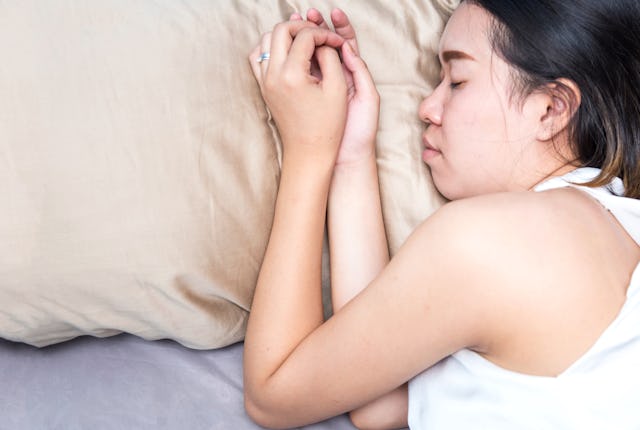Yes, Silk Pillowcases Really Are *That* Life-Changing
Frizzy hair, split ends, and fine lines — why dermatologists say silk linens can help with a lot.

While I’ve struggled with acne for years, my hair has always been something I’m most proud of. Thanks to my mama, I inherited a full head of voluptuous, fast-growing brown locks. Don’t get me wrong — I’ve struggled with my fair share of dead ends and tangled knots, but there were never issues I couldn’t bounce back from. Then, about a year ago, my hair betrayed me. I began experiencing thinning hair along my part and near my hairline. It was very noticeable, so I did what anyone else in my position would do: I turned to the internet for help.
The first thing I did was replace all my cotton pillowcases with silk pillowcases. Google brought me to Mulberry Park Silks, a luxury textile company that told me sleeping on silk could minimize my micro hair problems (split ends, frizz, and occasional dryness) and help manage my hormonal hair loss. I had also heard from friends who work in skincare that silk could be a helpful addition to combating dry skin and blemishes.
Fast-forward a year, and I’ve seen amazing results. Of course, I also had professional help from hair density serum and made a conscious effort to style my hair in clips rather than pulled-back, tight ponytails. But the overall appearance and texture of my hair did improve. And to that point, my skin is looking more refreshed than ever.
As dermatologist Brittany Buhalog, MD, FAAD, FACMS, told me in our interview: “Silk pillowcases aren’t a magic bullet, but they can be mildly beneficial.”
Still trying to decide whether you should make the switch to silk? Keep reading to learn why dermatology experts believe the luxury fabric may be worth the investment.
Can silk pillowcases and bed sheets improve your skin and hair?
Silk is the apex predator on the fabric food chain when it comes to the best material for pillowcases and bed sheets. “Naturally hypoallergenic, silk reduces irritation to sensitive acne- or eczema-prone skin that may easily be irritated by rougher materials,” chief dermatology resident Jamie Hu, MD, tells Scary Mommy. From a scalp standpoint, silk provides less friction or tugging and pulling on hair strands, adds Dr. Buhalog. Over time, this can lead to less breakage (split ends, tangled knots, dryness, or dullness) and healthier-looking hair.
Though an investment, silk also benefits your skincare routine. The moisture-wicking fabric will help keep your nighttime creams and serums where they belong: on your face. Comparably, moisture-absorbing fabrics such as cotton draw moisture and product from your skin, hair, and scalp, counteracting your bedtime self-care regime. (Not to mention creating a money drain!)
For a more hydrated glow, steer clear of synthetic fibers like those found in satin. “These can be more irritating and don’t have any of the other natural benefits of silk,” per dermatologist Alyx Rosen, MD.
Does sleeping on silk only benefit certain skin and hair types?
While sleeping in a silk cocoon can positively impact the face and scalp, dermatologists point out that certain skin and hair types may notice more significant results. “Those with textured or curly hair may experience more pronounced improvement in frizz and smoothness of hair, while individuals with acne- or eczema-prone skin may derive amplified benefits from silk’s hypoallergenic and friction-free properties,” explains Dr. Rosen. That isn’t to say those with straight or wavy hair or “normal” skin shouldn’t sleep on silk! Just don’t get discouraged if your hair isn’t totally transformed.
For those who wear a silk cap or bonnet to bed, Buhalog argues that you’re better off sleeping with your hair down or loose — but only if the cap’s primary purpose is to repair damaged hair. “Those caps can pull on hair due to the location of the elastic or because it’s tied tightly,” she explains.
How long do you have to sleep on silk to see results?
Improvements may occur within a few days or take months; it just depends. Hu says that by reducing the friction your hair experiences while tossing and turning mid-sleep, locks can look noticeably shiny and more moisturized within a few nights’ sleep. However, if you’re trying to improve the density and texture of your hair, that could take longer.
Similarly, your face may feel more hydrated and take on a more plump or youthful appearance almost immediately. And if your acne is driven by bacterial growth, you may also notice a difference soon into your silk journey, says Buhalog. But it’s important to note that switching to a silk pillowcase isn’t the cure-all treatment for acne.
“Switching your pillowcase to a silk fabric might make a difference, but it may not if hormones or excessive oil production are at play,” she says. In the case of the latter, Buhalog advises making an appointment with a dermatologist, who can help pinpoint the root of your acne and create a step-by-step action plan.
How often should you wash silk pillowcases and sheets?
“To reduce bacteria build-up that may contribute to acne and eczema flares, washing silk more often may be beneficial. But because silk is a comparatively delicate fabric, it is important to take note of the specific washing instructions on each product,” Hu cautions.
According to The Spruce, silk linens should be washed in cold water on the gentle cycle with a mild or gentle detergent. As with any delicate fabric, it’s best to wash silk by itself or with other similar textiles. Pillowcases should be turned inside out. Tumble dry on the lowest heat setting, or you can also hang silk to air dry.
You should wash your silk pillowcases and bedsheets at least once per week. However, factors like oily or sweaty skin, dirty hair, acne-prone skin, and even pets can play a role in how often you change out pillowcases.